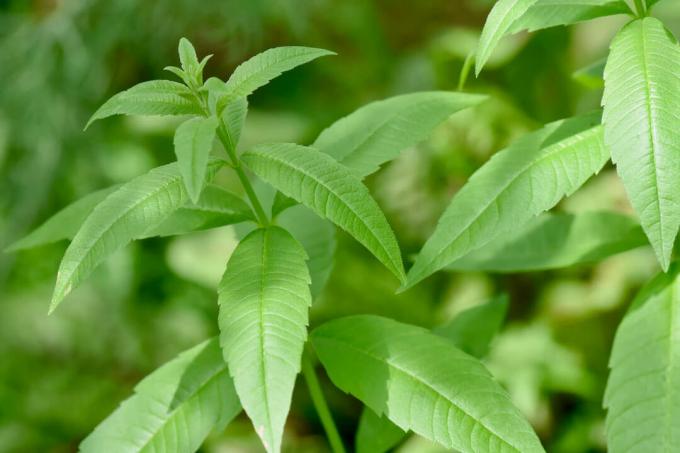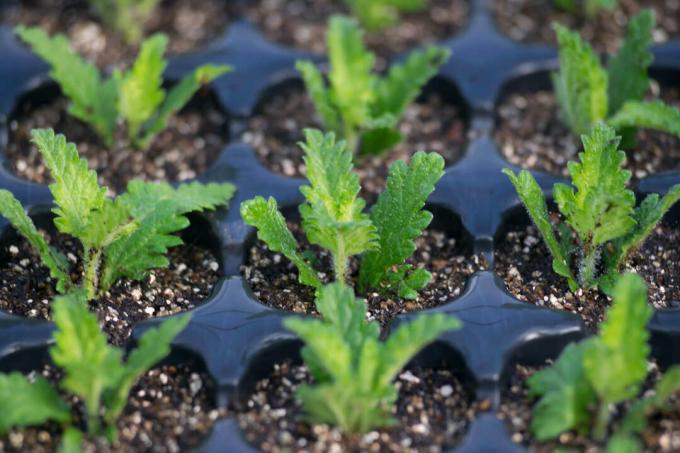Lemon verbena can be grown in the garden as well as in pots in the apartment or on the balcony as an insect-friendly, intensely fragrant herb with a wide range of uses.

The lemon verbena (Aloysia citriodora) is considered the refreshing herb par excellence and is also known under the names "lemon shrub" or "fragrant verbena" (French. known as "verveine odorante"). Like the one we have at home True verbena (Verbena officinalis) also lemon verbena belongs to the verbena family (Verbenaceae). We'll tell you what to consider when planting the lemon bush in the pot and in the garden Neighbors for the mixed culture and provide instructions for the propagation of lemon verbena cuttings.
contents
- Lemon verbena: flower, properties and origin
-
Plant lemon verbena
- The right location for lemon verbena
- Sow the seeds of the lemon verbena
- Good neighbors for lemon verbena
- Propagating lemon verbena
Lemon verbena: flower, properties and origin
Verbena originally comes from the subtropical regions of South America and only became popular at the end of the 18th century. brought to Europe in the 19th century. The genus name Aloysia commemorates Maria Luisa Teresa de Parma (1751 – 1819), the wife of the then Spanish king. Therefore, some foreign-language names of lemon verbena still contain a Luise element, as shown by the names "Hierba luisa" (Luise's herb) in Spain and "Luiserlkraut" in Austria. The Latin name has long been difficult. For example, common but not officially valid synonyms are Lippia citriodora or Aloysia triphylla, indicating the typical three-leaf leaf arrangement.

The lemon verbena is an attractive container plant for the terrace or balcony, but it is only partially hardy and only tolerates frost down to around -5 °C. The perennial and deciduous shrub reaches heights of around 1 to 2 meters in moderate climate zones in Europe. Under favorable conditions, for example in their home regions, the lemon verbena can even grow taller and reach dimensions of up to 3 meters. But if you want to grow lemon verbena in a pot, you don't have to be afraid, because there it usually doesn't get bigger than 1.2 meters. If you look closely, you can see dark spots, the so-called oil glands, on the elongated leaves of lemon verbena, which are usually sawn at the edges. Just a light touch on the leaves releases a refreshing citrus aroma. But even if the scent is strongly reminiscent of lemons, the lemon verbena is no closer to the lemon tree (citrus x lemon) which – like many other citrus plants – belongs to the rue family (Rutaceae) belongs. A real eye-catcher are the dainty flowers, which can range in color from white to pink to violet.

In our latitudes, the lemon verbena only finds good growth conditions between May and November. Lemon verbena flowers between July and September and is pollinated primarily by insects such as butterflies, carpenter bees and bumblebees. So your cultivation helps, for one more insect friendly garden to care. However, the seeds only ripen in long, warm summers.
Tip: A very close relative of lemon verbena is orange verbena (Aloysia citriodora ‘Orange’), which actually only differs in its scent, which is strongly reminiscent of oranges. However, in terms of uses and hardiness, orange verbena can be placed in the same category as lemon verbena.

Plant lemon verbena
Planting the Verbena odorante is easy as long as you follow a few pointers. If seed is found, lemon verbena can also be grown from seed. However, this requires a little more patience and care.
The right location for lemon verbena
Lemon verbena thrives best in a warm, sunny and sheltered spot. Since it is only partially hardy and therefore only survives extremely mild winters outside, lemon verbena can be grown in pots. It can even be grown as a year-round houseplant. In its original habitat, the lemon verbena prefers loose, neutral to slightly alkaline soil without waterlogging.
Plant lemon verbena in a pot: When cultivating in pots or tubs, the question of the right substrate always arises. For example, we recommend our Plantura organic potting soil. Due to the high content of organic matter, there is no need for peat. In addition, it is already pre-fertilized, so that the young lemon verbena plants are well supplied in the first months of growth. A sunny to partially shaded spot in a tub on the patio or in a pot on the windowsill is ideal. Depending on the growth, the lemon verbena should be repotted into a larger container about every one to two years. It is best to renew the soil as well. More about Care and wintering of lemon verbena can be found in a separate article.

Sow the seeds of the lemon verbena
Lemon verbena seeds can only be found at well-stocked retailers, but hobby gardeners can also harvest them from their own plants. However, their cultivation can be a bit tricky, as it can take a little longer for the seed to germinate, among other things.
- Sow from February in the greenhouse or on the windowsill.
- Fill the seed tray with a permeable, but still well water-storing substrate. Ours is a good example Plantura organic herb and seed soil.
- Distribute the seeds about 3 cm apart on the soil and only cover them very thinly, since lemon verbena is one of the light germinators.
- Then water everything well and place the planter in a bright place, but not in direct sunlight. The temperature should be constant around 20 °C.
- Now keep the soil consistently moist but not wet. A transparent cover, for example made of glass, helps to ensure optimal temperature and humidity conditions.
- The first seedlings should appear after about 2 to 3 weeks. Plants that are too close together can now be pricked out.
Regardless of whether you brought it up yourself or bought it – the young plants should be in their final place in the spring. If you want to enjoy your lemon verbena for several years, put the plants in pots, because they can easily be overwintered frost-free. But lemon verbena is also good as an annual plant in the garden.
- Plant out in tubs or beds from mid-May when the last frosts are over.
- choose pots that are at least 20 cm in diameter; Planting distance in the bed about 40 cm.
- In the case of pots, it is important to fill the bottom with a drainage layer of a few centimeters, made of sand, gravel or expanded clay, for example.
- Fill pots with loose, well drained and moderately nutritious substrate.
- Then water the plant well and place the pot in a sunny, warm place.
Good neighbors for lemon verbena
Plants that prefer similar locations and are therefore considered good neighbors for lemon verbena are, for example licorice (Glycyrrhiza glabra), some Johannis herbs-Species (Hypericum spec.) or lemon balm (Melissa officinalis). Also with coriander (Coriandrum sativum) or the very bee-friendly ones Indian nettles (Monarda) lemon verbena can be planted well together.

Propagating lemon verbena
The propagation of lemon verbena via seeds is difficult due to the fact that these usually do not ripen in our country. Therefore, propagation via cuttings is preferred.
For this purpose, about 15 cm long head cuttings, i.e. shoot tips, are cut off in spring or summer. Only freshly grown, soft or semi-soft shoots should be used. It is best to cut them off at the transition from the woody to the still green parts. The lower leaves are removed and the cuttings are then placed in pots with potting soil.
Rooting can be promoted by covering with foil, because lemon verbena cuttings should be kept in high humidity for reliable rooting. Rooting works best at temperatures between 18 and 25 °C and lasts about three weeks. When the first new leaves appear, the cuttings can be transplanted individually into pots. Then patience is required again, because only when the plants have reached a size of about 10 cm can the tip be cut for the first time. As a result, the shrub branches better and grows back bushier.
Tip: The separated leaves can be poured into a fresh tea, for example. What else you can use lemon verbena for and everything you can use to Harvest of lemon verbena should know, you will find out in a separate article.

In addition to lemon verbena, numerous other herbs grow in our home gardens, from which you can make your own tea. Check out our article for an overview of the best Herbal tea blends from our own garden.



